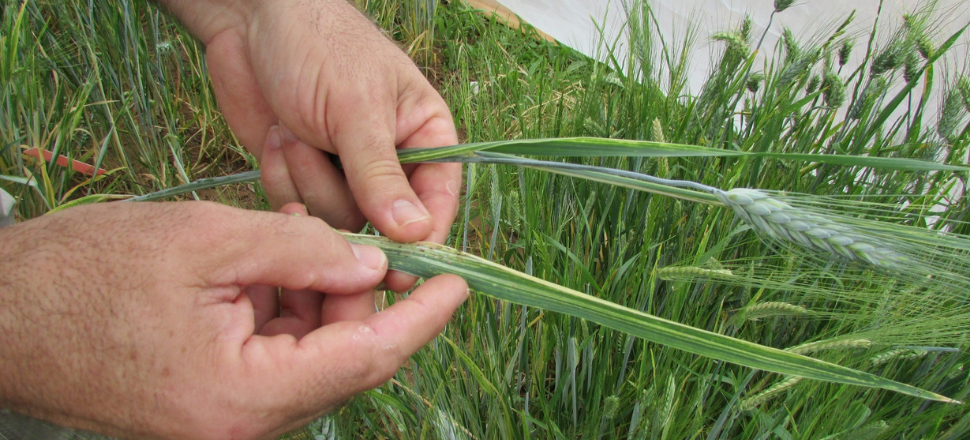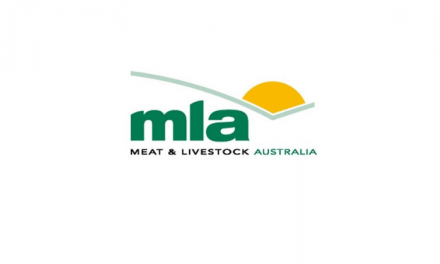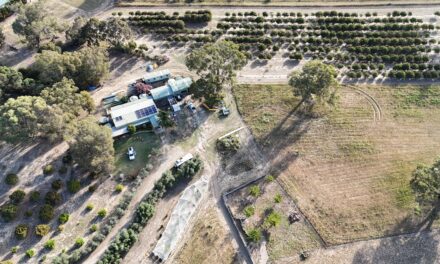Grain growers in southern and northern cropping regions are advised to keep an eye on their crops over the coming weeks as warmer spring conditions may promote flights of Russian wheat aphid (RWA).
RWA numbers have been minimal so far this season, due largely to low survival rates over the hot and dry 2018-19 summer.
Higher temperatures in spring may lead to an increase in aphid migration, but scientists say crops older than growth stage (GS) 40 do not appear to be attractive to migrating RWA, therefore colonisation of such advanced crops during spring is unlikely.
Rare cases of RWA presence and symptoms, below intervention thresholds, have been reported this year by growers and advisers in areas such as Victoria’s southern Mallee and East Gippsland, as well as the New South Wales Riverina, Central West Slopes and Plains, and the Central Tablelands.
Entomologists involved in Grains Research and Development Corporation (GRDC) research investments say economically significant yield impacts are more likely from infestations that occur before stem elongation, but only if these persist during the later (heading and flowering) stages.
Maarten van Helden, an entomologist with the South Australian Research and Development Institute (SARDI), the research division of Primary Industries and Regions SA, said detecting RWA in crops is not difficult as indications of infestation are usually quite obvious.
“A tell-tale sign is white or purple leaf streaking in cereal crops,” says Dr van Helden. “And at late tillering and during stem elongation, leaf rolling may occur.”
Growers should search for the presence of aphids by peeling back rolled leaves, since symptomatic tillers do not always contain aphids and therefore treatment may not be required if the aphids have either moved on or died.
First identified in Australia in 2016, RWA is now present in many cropping areas of SA, Victoria, Tasmania and NSW. The aphid has not been detected in Western Australia, the Northern Territory and Queensland.
RWA distribution is expected to move northwards again this year to northern NSW and possibly southern Queensland.
Since RWA has only been confirmed in Australia in recent years, limited research under local agro-climatic conditions and farming systems has been conducted.
As such, a GRDC investment, ‘Russian wheat aphid risk assessment and regional thresholds’, has been established to investigate regional risk and management tactics for RWA.
The collaborative investment is being led by SARDI, which is conducting research in partnership with sustainable agriculture research organisation cesar. Operation of field trials also involves a number of farming systems groups.
The GRDC investment is investigating how RWA survives between winter cropping seasons.
This knowledge is considered pivotal in determining the risk of infestation and potential damage ahead of each new cropping season, as well as aiding RWA management planning and development of cultural controls.
It is also seeking to determine the regional production risk posed by RWA and the economic thresholds that will guide growers in effective management of RWA, taking into account growing regions, crop varieties and climatic conditions.
This work is discussed in a new GRDC podcast (http://bit.ly/2TxL2T7) which features Dr van Helden outlining research efforts to provide Australian growers with guidance about if and when to action chemical control measures in order to avoid significant yield loss, and – conversely – to avoid time and money being wasted on unnecessary treatments, especially if sufficient predatory insect populations are present to act as a biological control.
“When the aphid was introduced into the United States in the 1980s, the Americans developed economic thresholds and so we are determining whether those same thresholds are valid in Australia,” Dr van Helden said.
“Current threshold recommendations for chemical control, based on US research, are more than 20 percent of seedlings infested with aphids up to the start of tillering and 10pc of tillers infested thereafter.”
Trial sites have been set up in SA, Victoria, Tasmania and NSW to determine scientifically robust thresholds under varying Australian conditions.
Dr van Helden said trials so far have shown that a considerable amount of RWA population pressure is required before yield loss is incurred.
“Overall, yield loss in our trials has not been as high as expected when aphid numbers have largely been above the overseas threshold. It seems that the overseas thresholds are, at this stage, acceptable for affected Australian grain growing regions.”
The current research effort builds on previous GRDC investments conducted by SARDI and cesar which focused on seasonal factors influencing RWA population growth, biotype confirmation, varietal susceptibility, damage and yield loss, and chemical efficacy.
Research will culminate with an update of the GRDC RWA Tips & Tactics guide, which can be found at https://grdc.com.au/TT-RWA.
Growers and advisers will also have the opportunity to keep up to date with the research through fact sheets, research updates, newsletters, webinars and trial site visits.
In the meantime, further information on RWA management is contained in the Russian Wheat Aphid: Tactics for Future Control publication, available at https://grdc.com.au/rwa-tacticsfuturecontrol, as well as I SPY, a comprehensive crop insect identification manual, which can be viewed at https://grdc.com.au/I-SPY.
A RWA resource portal (including a constantly updated aphid distribution map) hosted by cesar is available at http://bit.ly/2Px67tu.
A cesar-produced Pest Bites video on identification of RWA can be viewed via http://bit.ly/2N7uwIG.
Growers and advisers are encouraged to report occurrences of RWA in known areas of distribution to the GRDC’s PestFacts services (http://bit.ly/2O3hoBj for south-eastern, and http://bit.ly/2O35bMX for SA) and the Beatsheet (https://thebeatsheet.com.au/) for the northern grains industry.
Suspected infestations in previously unaffected regions should be reported to the Exotic Plant Pest Hotline on 1800 084 881.
Growers can take advantage of pest identification services provided by cesar and SARDI through the National Pest Information Service.







